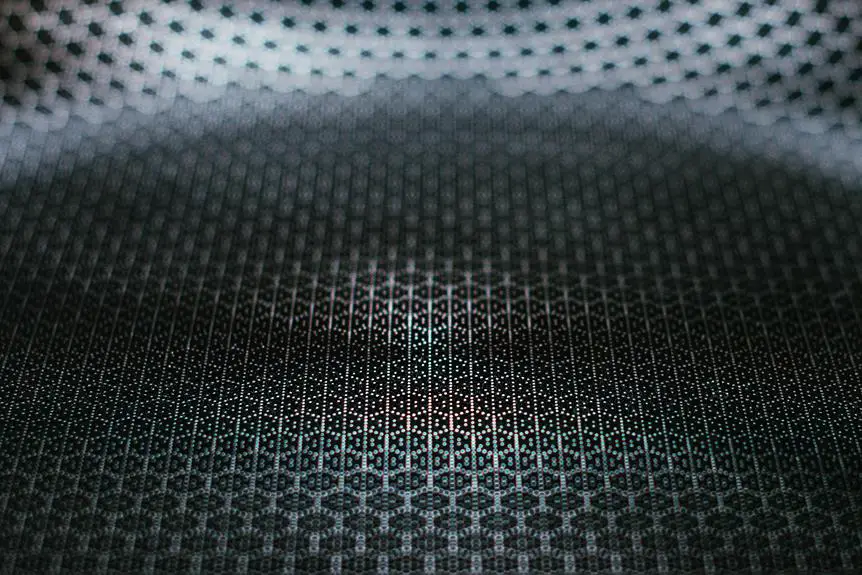When it comes to ironing bamboo fabric, you'll want to approach the task with care to preserve its natural qualities. Start by setting your iron to a low or medium heat, ideally around 300°F, and don't forget to use a pressing cloth to shield the delicate fibers. As you glide the iron over the fabric, you'll discover the importance of technique and steam, but there are a few common pitfalls you should avoid. Understanding these nuances can make a significant difference, so let's explore the best practices that will help you achieve optimal results.
Table of Contents
Key Takeaways
- Set the iron to low or medium heat, ideally around 300°F (150°C), to protect delicate bamboo fibers.
- Use a pressing cloth to shield bamboo fabric from direct heat during ironing.
- Steam lightly to relax fibers and remove wrinkles, but avoid excess moisture to prevent damage.
- Iron while the fabric is slightly damp for better results and to minimize the risk of scorching.
Understanding Bamboo Fabric
Bamboo fabric's unique properties make it a popular choice for those seeking soft, breathable, and eco-friendly textiles. When you touch bamboo fabric, you'll immediately notice its silky feel, which comes from the natural fibers derived from the bamboo plant. This softness makes it an attractive option for clothing, bed linens, and towels.
One of the standout features of bamboo fabric is its breathability. It allows air to circulate, keeping you cool in warm weather and warm in cooler conditions. This moisture-wicking ability helps you stay dry and comfortable, making it ideal for activewear or sleepwear. Plus, bamboo's natural antibacterial properties help reduce odor, making your items fresher for longer.
You'll also appreciate that bamboo is a sustainable resource. The bamboo plant grows quickly and requires less water than cotton, contributing to its eco-friendliness. Additionally, its cultivation doesn't typically involve harmful pesticides or fertilizers, which is a plus for the environment.
Understanding these characteristics will help you appreciate why bamboo fabric is an excellent choice for your wardrobe and home. When you choose bamboo, you're not only opting for comfort but also making a more sustainable choice.
Preparing for Ironing
Before you start ironing your bamboo fabric, check the care label for any specific instructions.
Once you've confirmed the guidelines, set up your iron to the appropriate temperature for bamboo.
This prep work ensures you get the best results without damaging the fabric.
Check Care Label
It's essential to check the care label on your bamboo fabric to ensure proper ironing instructions are followed. This label provides crucial information regarding the fabric's care, including the recommended temperature settings and whether ironing is even advisable. Bamboo fibers can be sensitive to high heat, so knowing the correct guidelines is key to avoiding damage.
Look for symbols indicating the maximum ironing temperature. Typically, bamboo fabric should be ironed at a low to medium heat setting, often represented by one or two dots on the care label. If the label advises against ironing, consider steaming instead. This method is gentler and can effectively remove wrinkles without direct contact.
Additionally, check for any specific instructions related to steam settings. Some bamboo fabrics may tolerate steam, while others might not. Keep an eye out for any warnings about using starch or other products, as these can also affect the fabric's texture and appearance.
Set Up Iron
Once you've checked the care label, set up your iron by adjusting the temperature to low or medium heat, according to the fabric's guidelines. Bamboo fabric is delicate, so it's essential to avoid high temperatures that can damage it.
Before you start ironing, make sure your ironing board is clean and set to a comfortable height. Lay your bamboo fabric flat to minimize wrinkles before applying the iron.
Here's a quick reference table for your convenience:
| Temperature Setting | Fabric Type | Ironing Tips |
|---|---|---|
| Low | Bamboo | Use a pressing cloth |
| Medium | Cotton/Bamboo Mix | Keep the iron moving |
| High | Cotton | Avoid direct contact |
| Steam | Synthetic Fabrics | Use for stubborn wrinkles |
| Dry | Wool | Iron while slightly damp |
Using a pressing cloth can help protect your bamboo fabric from direct heat. Keep the iron in constant motion to prevent burns or shine marks. With these precautions, you'll ensure your bamboo items look fresh and well-maintained!
Setting the Right Temperature
When ironing bamboo fabric, you need to set the right temperature to avoid damaging it.
Typically, you should aim for a moderate heat setting, but knowing the ideal range is crucial.
Let's explore how to prep before you start and ensure your fabric stays in great shape.
Ideal Temperature Range
Finding the ideal temperature range for ironing bamboo fabric is essential to prevent damage and achieve a smooth finish. Bamboo fabric is delicate, and using the wrong temperature can lead to unwanted results. To ensure you're on the right track, follow these guidelines:
- Set your iron between 280°F to 320°F (140°C to 160°C): This is the sweet spot for bamboo fabrics, allowing you to smooth out wrinkles without harming the fibers.
- Use the steam function wisely: If your iron has a steam option, use it to help relax the fabric. Just make sure you don't overdo it, as excess moisture can weaken the fibers.
- Always test on a small area first: Before you dive into ironing, test on an inconspicuous section of the fabric. This helps you gauge how the fabric reacts to heat.
- Keep the iron moving: Avoid leaving the iron in one spot for too long. Gently glide it over the fabric to prevent scorching.
Avoiding Fabric Damage
Setting the right temperature is crucial for avoiding fabric damage, as bamboo's delicate fibers can easily be harmed by excessive heat. When you begin ironing, ensure your iron is set to a low to medium temperature, typically around 275°F (135°C). This setting helps you maintain the integrity of the fabric without compromising its softness or strength.
Always check the care label on your bamboo fabric before you start. If it suggests a specific temperature, follow that guidance closely. If you're uncertain, err on the side of caution; it's better to use a cooler setting and make a few extra passes than to risk burning or scorching the material.
As you iron, keep the iron moving to prevent hot spots that can lead to damage. Avoid pressing down too hard; let the weight of the iron do the work for you. If you notice any signs of shine or melting, stop immediately, as these indicate the fabric is encountering too much heat.
Pre-Ironing Preparation Tips
Before you start ironing, gather all necessary supplies and ensure your iron is clean and ready to use.
Setting the right temperature is crucial for bamboo fabric, as it's delicate and can easily be damaged if you're not careful. Bamboo typically requires a low to medium heat setting.
Here's how to prepare:
- Check the Label: Look for specific care instructions on your fabric label. This will give you insight into the recommended ironing temperature.
- Adjust the Iron: Set your iron to the appropriate temperature, usually around 300°F (150°C) for bamboo. If your iron has a steam function, you might want to use it lightly.
- Test a Small Area: Before diving in, test the iron on a small, inconspicuous area of the fabric. This ensures that the heat won't cause any damage.
- Use a Pressing Cloth: To further protect the fabric, consider using a pressing cloth between the iron and the bamboo. This adds an extra layer of security against heat damage.
Best Ironing Techniques
To effectively iron bamboo fabric, always use a low heat setting to prevent damage while ensuring smooth results. Start by checking the care label on your bamboo garment, as some blends may require specific temperature settings. Place the fabric on an ironing board, ensuring it's clean and flat.
When you're ready to iron, hold the iron just above the fabric's surface. This helps avoid direct contact that could scorch the material. Glide the iron gently over the fabric, working in sections, and avoid lingering too long in one spot. If you notice any stubborn wrinkles, you can lightly press down, but remember to keep the heat low.
For best results, reposition the fabric as needed to keep it taut. If the fabric starts to stick, lift the iron slightly and adjust its position instead of applying more pressure.
Using Steam Effectively
Using steam can significantly enhance your ability to remove wrinkles from bamboo fabric without risking damage. By utilizing the steam function on your iron, you can effectively relax the fibers, making it easier to achieve a smooth finish.
Here are some best practices for using steam effectively:
- Preheat the Iron: Make sure your iron is fully heated before adding steam. This ensures that the steam penetrates the fabric efficiently.
- Hold the Iron Upright: Instead of pressing the iron directly onto the fabric, hold it upright a few inches away. This lets the steam rise and reach the fabric without direct contact, minimizing the risk of scorching.
- Use a Pressing Cloth: If you're concerned about direct steam exposure, place a thin cotton cloth between the iron and the bamboo fabric. This protects the delicate fibers while still allowing steam to pass through.
- Work in Sections: Apply steam to one section at a time. This allows you to focus on areas that need extra attention without overwhelming the fabric with moisture.
Tips for Storing Ironed Fabric
How can you ensure your freshly ironed bamboo fabric stays wrinkle-free while in storage?
First, let the fabric cool completely after ironing. This prevents creasing from residual heat. Once cooled, fold the fabric neatly. Avoid heavy folds; instead, use light creases to maintain its smooth appearance.
When storing, choose breathable materials. Cotton or linen storage bags work wonders, as they allow air circulation, reducing moisture buildup. Avoid plastic bags, since they can trap humidity and promote mildew. If you must use plastic, ensure it's breathable.
Keep your ironed bamboo fabric in a cool, dry place. A closet away from direct sunlight is ideal, as UV rays can fade the fabric over time. If you're storing it for an extended period, consider placing a few cedar blocks or sachets in the storage area. These natural deodorizers also help repel pests.
Lastly, if you notice any wrinkles after storage, simply hang the fabric in a steamy bathroom for a few minutes. This gentle method helps release creases without additional ironing, keeping your bamboo fabric looking fresh and beautiful.
Common Mistakes to Avoid
Even with proper storage techniques, it's easy to make common mistakes when ironing bamboo fabric that can lead to unwanted wrinkles or damage. To help you navigate the ironing process smoothly, here are some pitfalls to avoid.
- Ignoring the Care Label: Always check the care label for specific ironing instructions. Bamboo fabric often has unique requirements that can differ from other materials.
- Using High Heat: Bamboo is sensitive to high temperatures. Using an iron set to high heat can scorch the fabric, resulting in permanent damage. Stick to a low to medium setting.
- Ironing Dry Fabric: Ironing bamboo fabric when it's completely dry can make it more prone to wrinkles. Instead, lightly mist the fabric with water or iron it while it's still slightly damp.
- Forgetting to Use a Pressing Cloth: Protect your bamboo fabric by placing a thin pressing cloth over it while ironing. This extra layer prevents direct contact with the iron, reducing the risk of scorching.
Frequently Asked Questions
Can I Iron Bamboo Fabric While It's Still Damp?
You can iron bamboo fabric while it's still damp. Doing so helps remove wrinkles more easily. Just make sure to use a low heat setting to avoid damaging the fibers and maintain the fabric's quality.
What Type of Iron Is Best for Bamboo Fabric?
For bamboo fabric, a steam iron works best. It helps you avoid scorching while providing moisture, making wrinkles easier to remove. Just ensure the iron's temperature is set to low to prevent damage.
How Often Should I Iron Bamboo Garments?
You should iron bamboo garments only when necessary, usually after washing or if they've been stored for a while. Frequent ironing can damage the fabric, so try steaming for a gentler approach instead.
Is It Safe to Use a Spray Starch on Bamboo Fabric?
Yes, you can use spray starch on bamboo fabric, but do so sparingly. It's best to test a small area first to ensure it doesn't alter the fabric's texture or color before applying it widely.
Can I Dry Clean Bamboo Fabric Instead of Ironing?
Yes, you can dry clean bamboo fabric instead of ironing. It's a safe method that helps maintain the fabric's integrity and appearance. Just make sure to choose a reputable dry cleaner familiar with delicate fabrics.
- Recycling Nonwoven Fabrics: Is It Possible? - July 11, 2025
- Recycling Nonwoven Fabrics: Is It Possible? - July 11, 2025
- Recycling Nonwoven Fabrics: Is It Possible? - July 11, 2025







